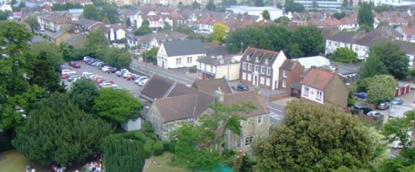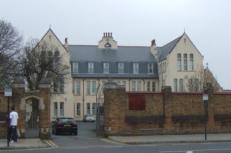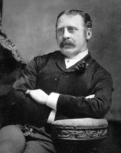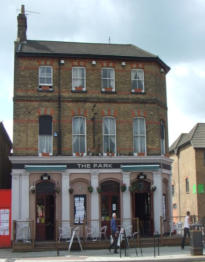Timeline
1860
National Mixed School was erected.
1-15
Nelson
Street
was
the
original
focus
of
shopping
in
Southend
prior
to
the
development
of
the
High
Street.
It
was
built
about
1860
as
the
shopping
street
for
the
'new'
Cliff
Town
Estate.
Note
in
particular
the
unusual
raised
York
stone
pavement
and
the
only
remaining original shop-front can be seen at number 15.
1861
Seafront
Chapel
was
built.
Old
Leigh
fisherman
Michael
Tomlin
who
preached
the
gospel
all
over
south-east
Essex,
gained
a
new
chapel
in
1861.
A
large
brick
building
appeared
on
Eastern
Esplanade
just
next
door
to
the
original
Castle
public
house;
today
the
same
site
is
now occupied by the Sea Life Centre.
The
Elms
Pub
on
London
Road
started
life
as
a
farm.
The
house
was
built
this
year,
and
nearby
stood
a
fine
elm
called
Ellen's
or
Adam's
Elm,
which
measured
about
thirty
feet
in
circumference.
It
disappeared
in
the
1830s
but
gave
its
name
to
the
farm,
subsequently
the
hotel and now the pub.
1862
Horseshoe
Barracks,
Shoebury,
completed
in
1862.
Buildings
in
a
formal
‘horseshoe’
layout
enclosed
the
parade
ground.
They
were
barrack
blocks
with
separate
cook
houses
to
the
rear,
a
Sergeants’
Mess,
Garrison
School,
and
an
arched
gateway
and
clock
tower
flanked
by
the
guardroom,
cells
and
offices. Their unique design showed reformed standards of military accommodation.
1863
Southend
invaded
by
the
Royal
Marines
as
part
of
a
major
naval
exercise.
This
mock
invasion
entertained
locals
and
holidaymakers
alike.
The
town
was
defended
by
infantry,
artillery
and
engineers;
and
was
attacked
by
1,000
Marines
and
naval
ratings
under
Admiral
F.
W.
Hope
Johnstone,
Commander
in
Chief
of
the
Nore.
The
attackers
effected
a
landing
and
penetrated
into
Cliff
Town,
but later retired to their boats.
The
Knapping
family
formerly
lords
of
Shoebury
manor
developed
the
Knapping
Estate,
a
stretch
of
foreshore
near
Rampart
Terrace.
Dale Knapping J. P. erected the National School in 1863 on the site of St Peter's church.
1864
The High Street Chapel built in 1806 closed. The chapel built to accommodate the growing parish closed in 1864. It was located west of the High Street just north of the Clarence Street junction. The Cliff Town Church was due to open in 1865 which would be more substantial and able to cope with the growing town. 17th November. Milton Hall Cricket Club was formed.1865
Messrs.
Peto,
Brassey
&
Betts,
the
famous
firm
of
Railway
Contractors
build
a
Pumping
Station
Milton
Road
and
reservoir
in
Scratton
Road
and
supply
water
to
Cliff
Town,
Southend. A private undertaking operated the works until 1871.
The Cliff Town church opened its doors in 1865 to the growing parish of central Southend, a structure in the Gothic style, was erected at a cost of £3,000, with a tower containing an illuminated clock and bell. Up until now the locals were served via the churches of Prittlewell and Southchurch and in 1842 St John the Baptist Church. This new place of worship would provide relief to the overcrowding of the current churches. 1866 The Garrison Church of St Peter and St Paul was originally the chapel and school of the British School of Gunnery. It was constructed this year of ragstone and slate in a Gothic revival style, with a cruciform plan. Memorials in the church include one to the accidental explosion of 1885. A row over a very foul ditch in the old part of Southend led to the town’s first independent form of local government - the Southend Local Board of Health. The Cricketers, Leigh Road/London Road opens as a Inn, previously was two cottages. 1867 Police force doubles in size. Southend along with the many other parishes of the area was served by a Police Sergeant, in 1867 Southend's manpower was double with the posting of a Constable, at the time the Police Station existed in a house in Hamlet Road. It wasn't until 5 years later the growing town needed more policing and better accommodation, and two houses in Alexandra Street would provide the need adequately. 1868 New School moves. Prittlewell became even more established in 1868 with the arrival of St Mary's School in East Street. The school originally goes back to the 15th century when it was established by the Jesus Guild. The school in 1998 moved again to take over the vacated school premises on Boston Avenue formerly Southend High School for Girls. The East Street school buildings subsequently came under the use of South East Essex College. The Porters Estate reduces. Porters known today as the Mayor's Civic House; but was in its time one of the most prestigious estates in the county. 1868 saw the land mass reduce considerably prior to this the estate extended down to the coast. But with an exact division by ten the land was auctioned off for development. The house and 29 acres of land were sold to a famous name James Heygate whose family were instrumental in the development of the town. 1869 The Scratton estates in Southend are put up for sale. Luker’s Brewery moves to the High Street from its former site in Brewery Road. The Roman Catholic church of Our Lady Help of Christians and St. Helen Empress, situated in Milton Road, Westcliff, was erected at a cost of more than £2,000, and enlarged in 1900-3 at a further cost of £2,000, and consisted of chapel, nave, north and south aisles, lady chapel and a turret containing 2 bells. The Archbishop of Westminster opened the church in October. The building was designed by architect W. J. Goodman. The first parish priest to serve this church was Father John Moore. Adjoining the church was a convent school. Hamlet Mill Demolished. It is hard to believe now on the corner of Avenue Road and Park Road sat a full scale operational windmill which could be traced back to 1299 when it is recorded a new mill was built at this point at the cost of £15 5s.10d. It was here that John, Earl of Holland, half brother to Richard II, was captured by the villagers of Milton while trying to escape after an unsuccessful plot against Henry IV. Avenue Road indeed was originally called Mill Lane and is one of the oldest roads in the borough. Milton Hall estate sold. One of he oldest buildings in Southend was sold as part of the Milton estate in 1869. The Hall was originally bought for a school but it was not until 1880 that it was acquired by the Sisters of Nazareth, who ran it as an orphanage and more lately a home for the elderly. The Hall has now virtually disappeared through all the additions that have been made to the building. Interestingly in the crypt lie the remains of Clement Scott a celebrity of the stage during the 1890s, known for authoring the song "The Garden of Sleep," also the remains of Bishop Bellord a war-tried army chaplain. 1870 Southend's Brewery moves. Luker's Brewery was built just off High Street in 1869 through to 1870. Having moved from their original site in Brewery Road (now Southchurch Avenue). The Cricketers. Originally two cottages and opening as an Inn in 1866. The Cricketers came to life on 25th March 1870. The pub over the year's had an interesting history and not just for serving beer. In the earlier 1900s the landlord at the time Alex White set-up a horse drawn fire engine housed in the rear courtyard and proving the forerunner to the town's first formalised fire service. Milton Chapel was built and saw the arrival of the Wesleyan Chapel at the junction of Avenue and Park Road. The building would soon become the Park Road Methodist Church, and considered at the time as the town's 'greatest architectural ornaments'. It is now a listed building, and an important townscape feature being built out of Kentish Ragstone. Currently it is not used for religious purpose but owned privately. Halfway House built. A suitable hostelry for the consumption of food and beer was built this year, halfway between Old Southend and Shoeburyness. Originally positioned on Southchurch Beach, but with road development the site of the pub now sits alongside Eastern Esplanade. Cambridge Town develops. Shoebury saw the arrival in this year of the School of Artillery. As with army areas the whole infrastructure around develops too, so Shoebury had a new area named after the Duke of Cambridge (1819-1904) the Army Commander-in-Chief. The area would keep developing for another 20 years to accommodate its new military guests. St Mary's in Prittlewell, underwent a major renovation. Considering its history, dating back to Saxon times there was a need to bring this central church into a new era. The work would see major roof work across the building with the arrival of the magnificent oak roof structure which can be seen today. The sisters of Notre Dame buy the Mitre Hotel in Milton road and turn it into St. Mary’s convent, later to be taken over by the Bernardine sisters (St Bernard’s School) from France in 1918. The building was certified as an orphanage for fifty children in 1879 and a day school in 1889. Southend Rugby Club founded.1871
Pumping
Station
Milton
Rd
and
reservoir
in
Scratton
Rd
which
supply
water
to
Cliff
Town,
are
transferred
to
the
new
Southend
Waterworks Company Ltd.
Thomas William Ingram, brought the first floating swimming baths to Southend. A Princess at Porters. Princess Louise, 4th daughter of Queen Victoria, who married the Marquis of Lorne (afterwards 9th Duke of Argyll) in 1871, inhabited 'Porters' for a short time. Miss Tawke, in her 'Recollections' wrote: 'I think Lord Lorne (as he was at that time) was going through a course at Shoebury'. This would probably be when he was a young officer, about the time of or soon after his marriage. During 1871 and 1872 the local board licensed the very first Hackney Carriages. "First Class" carriages charged 1s per mile, and "Second Class" was 9d. New Methodist Chapel Park Road gained a new Methodist Chapel at a cost of £2,500, a gothic build with a minster's house and school room added later to the structure. 1872 Public Hall built. A much needed facility on Alexandra Street popped up in 1872, the Public Hall would host many events not least entertainment. So it was no surprise the building changed name to the Empire Theatre, tragedy struck however in 1895 when it was completely destroyed by fire. A rebuilt theatre emerged and survived up to 2008. John Rumbelow Brightwell’s Drapery Store was founded. 1873 Medical Officer appointed for Southend at a princely salary of five guineas a year. Group of amateurs called the Royal Alexandra Dramatic Club produced “Lady Audley’s Secret” at the Public Hall. Ben Emery in his bawley started the Leigh whitebait industry. A Gentlemen's club is born. Wednesday 15th January at 8pm, eleven gentlemen met at Edward Barron’s house in Clifftown Parade. The purpose of their meeting was to discuss the formation of a club for “gentlemen of known respectability.” Clearly much thought had already gone in to the venture as George Lay, a newly qualified local solicitor presented to the meeting a draft set of rules many of which still survive to this day. The club was to be named after the Princess of Wales, later Queen Alexandra, and to be known as “The Alexandra Club.” It was not until 1878 the club was to become a yacht club. In 1884 it moved to its current location on the cliffs above Western Esplanade. Southend's first newspaper. On 9th May 1873 Southend’s first regular weekly newspaper was published for the first time. This was the Southend Standard. Originally printed in premises in Southchurch Avenue, printing moved to purpose-built premises in Clifftown Road, known as Standard House. 1874 Marine Park opens. Later to house the Kursaal area, the Marine Park was opened in 1874 along with gardens and walkways. It had, in its time, cricket and football pitches, and a trotting track. Even after the Kursaal was built, a football pitch existed in the north-east area of the grounds and it was home to Southend United for a time, the entrance being from the bottom of Park Lane from 1914- 1934. Southend Cricket Club formed. Starting out as the Milton Hall Cricket Club in 1864 it reformed as the Southend Cricket Club. The first Police Station and Court House, in Alexandra Street, is erected at a cost of £4,250, a new Court House is added in 1924 at a cost of £6,000. A much needed amenity as along with it was a court room. The town was now becoming so popular for visitors that naturally crime was happening. Although the compliment of the force at this time was quite minimal with no more that one sergeant and four constables, and one bicycle. It was quite common for the police to rely on the support of the army based at Shoebury in the event of any major disturbances. Thomas Dowsett seeks permission from the Local Board to build a new road called Market Place. 1875 Local Board inaugurated Southend fire brigade. 1876 Concerts started on the Pier in the Octogon. This was a marquee not far from the shore, but the pier railway ran through it and when meetings or entertainments were being held, the proceedings were halted while the horses clomped through the tent, pulling the carriages. a warning bell was sounded when the horse-tram was near. Alexandra Street unveiled another theatre in its midst. Already enjoying the use of the Public Hall, next door the 'Theatre of Varieties' opened, to quench the thirst of the cultural hoards pouring into the town. Prior to this and the Public Hall, the only other theatre was Trotters down on Eastern Esplanade. The offer to the visitor needed to be more enduring and weather reliant, plus the town's residents were building in number and needed entertainment too. A new manufacturing company, established in 1876, would make and provide scales for shops, farms and factories, G. Perry & Sons became the first scale makers in Southend. Building plans were submitted to the Local Board this year for a new public house, the Park Tavern, it still exists today with it's prominent frontage on the London Road, but its name reflected then Southend's first public park which is no more, it existed south of the London Road covering a few acres and included a lake and cycle racing tracks for Penny Farthings. The Theatre of Varieties in Alexandra Street opened an outdoor roller rink complete with bandstand, aviaries, fountains and rock gardens. The marketing for this venue centred around the regular patronage of clergy. Southend Temperance Society started in 1876, due to the number of problems created by alcohol. The society set up a reading room to take people's minds off the evils of drink. However, the society lasted only one year due to a lack of interest. 1877 September. The town’s first fire engine arrived. It was met by a procession headed by the town band and taken opposite the Ship Hotel where there were fireworks and a bonfire. The Board agreed those who had volunteered to form a fire brigade, Messrs. Belcham, Brewer, Berry, Storey, Appleby and F. J. Woosnam, to be given helmets, tunics and belts. it was also agreed to rent a shop in Market Place off Alexandra Street, for storing the the fire engine - a second hand appliance costing £80. March. The first fire the brigade attended was at Young’s shop opposite the post office in the High Street, in March 1878. The horses to draw the engine were kept in Scott’s stables. 26th October. Southend was spreading out and the union between the original village of Prittlewell and the South End became more established through the formalisation of the parish of All Saints, soon to reach a population of some 11,000, and included within its boundary the LNE Railway Terminus now known as Victoria Station. The Parish named after All Saints church in Sutton Road and included the area known as Porters Town. this parish contains some of the oldest streets in Southend. It was not until 1914 the area became a ward in its own right. The land area also included the stadium. The church, erected was an edifice of red brick with stone dressings in the Early French Gothic style, and consisted of chancel, lady chapel, nave and aisles, a chapel, completing the east end of the north aisle, three vestries and vicarage were completed in 1925 at a cost of over £4,000. The baptismal register dates from the year 1877. A memorial, designed by Sir Charles Nicholson bart. F.R.I.B.A. was erected in the churchyard in memory of the 102 men of the parish who fell in the Great War, 1914-18. An author is born. Southend has many literary associations but with George Warwick Deeping Southend can at least lay claim to his birth in the town in 1877. Not only was he born in Southend but on the High Street in Prospect House right opposite the Royal Hotel. Mr Deeping would take a career as a novelist. Deeping went on to write some 60 books and had a tremendous following although he did shun the limelight, he died in 1950, and a memorial stone has been placed in St John the Baptist Church graveyard. More recently the underpass going from Victoria Circus to Southchurch Road was called 'The Deeping' in his memory. Yacht Race. A prestigious yacht race around England started and finished this year at Southend Pier. 3rd December. The memorial stone of Trinity Church, Southend was laid, this was the first Reformed Episcopal church built in the United Kingdom, and was an edifice of brick and stone in the Early English style. In 1925, Trinity rectory was built adjoining the church. 1878 Alexandra Club gets its sails. A significant year for the Alexandra Club when it was suggested by a Mr William Brighten that it should become a sailing club. The club was originally established in 1873 and took up rooms in Alexandra Street; so the suggestion would lead the club to taking up new premises to its current site clinging onto the slope above Western Esplanade. Southend like most towns of this era employed a town crier to provide news and announce events happening. However, this year the official Town Crier was stricken with gout and unable to perform his duties. Oldest Esplanade completed. From Pier Hill to the Kursaal, the oldest part of the esplanade along Marine Parade was completed. December. Southend Tax and Ratepayers Association was formed, Chairman was Mr. W. G. Brighten. 1879 First lifeboat was stationed on the pier. The Thames Estuary has claimed many lives so it was no surprise that the first lifeboat station was set up in Southend in 1879. Since then the crews of the lifeboats have successfully saved over 2,000 lives. The lifeboat station was based at the end of the pier pretty much as it is today. The first lifeboat was named on 13th November "Boys of England and Edwin J. Brett." First portion of Victoria Avenue is made up and extends as far as the proposed Railway Station. Ingram’s warm baths below the Royal Hotel are demolished to make way for a new Pier toll house.
Southend Timeline Southend-on-Sea © 2009 - 2024. All Rights Reserved
1860 - 1879











Clock Tower Garrison
St Mary’s School Prittlewell
Princess Louise
Milton Hall/Nazareth House
Clement Scott
Wesleyan Chapel Park Road
St Mary’s Church Prittlewell
Park Tavern
Esplanade Marine Parade
Elms Public House
Cliff Town Church



Website Info:

Southend-on-Sea’s No 1 History Website! Documenting The Town & The Townspeople
Now Incorporating The Sea Of Change Website


SOUTHEND CITY
Chalkwell ▪ Eastwood ▪ Leigh-on-Sea ▪ Prittlewell ▪ Shoeburyness ▪ Southchurch ▪ Thorpe Bay ▪ Westcliff-on-Sea
































































